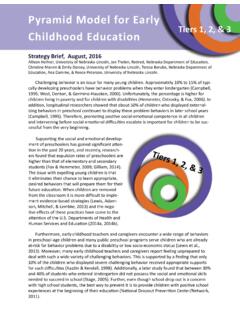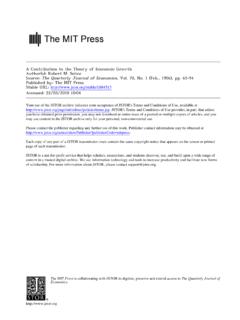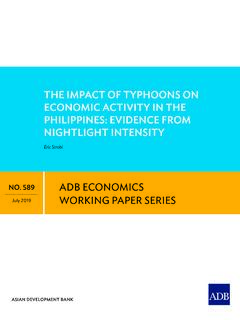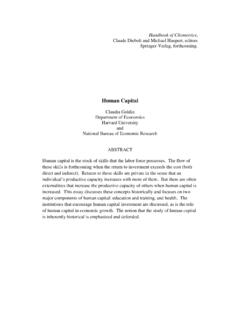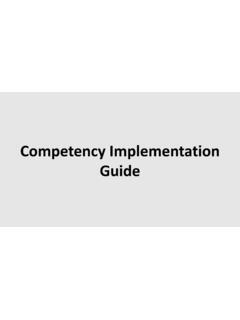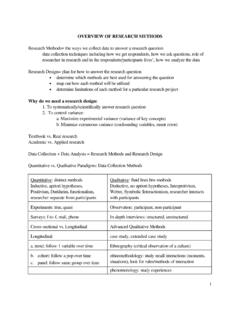Transcription of SUSTAINABILITY: A MOVEMENT
1 sustainability IN THE WORKPLACE 1 sustainability : A MOVEMENT sustainability IN THE WORKPLACE 2 sustainability : A MOVEMENT The organizations and resources included in this white paper are provided for reference only. The Department of Labor and the Occupational Safety and Health Administration take no responsibility for the views, content or accuracy of this information. Their inclusion, including the mention of trade names and commercial products, does not imply endorsement by the Occupational Safety and Health Administration1 (OSHA) recognizes that new strategies are needed to ensure that all workers return home safe, sound, and healthy from a day on the job. Workplace safety and health standards and their enforcement can have a huge impact on workers lives but the OSHA standard setting process is slow and even full compliance with standards will not prevent all work injuries and illnesses. There is much untapped potential to leverage other movements that are big, proactive, diverse in audience and stakeholders, future-thinking, and innovative to advance worker safety and health.
2 sustainability is one such MOVEMENT that provides the potential to go beyond the Agency s traditional role and become a transformative in the integration of environmental, social, and economic considerations, the sustainability MOVEMENT has steadily gained power and traction. Individual organizations (companies, local and state governments, etc.) have been using sustainability as a platform for decision-making and transparency efforts. OSHA is not looking to redefine or reinvent sustainability ; occupational safety and health (OSH) is already a component of existing conceptual models. However, in practice, the sustainability MOVEMENT has focused more on environmental concerns, leaving key social and workplace considerations, such as OSH, behind. The sustainability MOVEMENT is going to continue to advance whether or not OSHA and the OSH community choose to actively engage. Where OSH is not part of the discussion, individuals, companies, and organizations that present themselves, their activities, or their products as sustainable may not be doing what is best for their workers.
3 A building, no matter how energy efficient or healthy for occupants, is not sustainable if a construction worker is killed while building it. Furniture, no matter how responsibly the wood is harvested, is not sustainable if a woodworker loses a limb during manufacturing. The poultry supply chain, no matter how well free-range chickens are treated, cannot be sustainable when workers endure crippling musculoskeletal disorders while processing those chickens. Employers are only truly sustainable when they ensure the safety, health, and welfare of their workers. OSHA has undertaken this project as a way to assess the current sustainability landscape, understand how OSH is integrated (or not) into sustainability efforts, and identify opportunities to leverage the sustainability MOVEMENT to promote worker safety and health. This white paper was developed as a result of more than 80 conversations and the review of many articles, publications, reports, and frameworks.
4 It lays out OSHA s understanding of sustainability , key areas where stakeholders are currently engaging, recognized opportunities and challenges, and potential actions that could advance OSH within sustainability discussions. These ideas are just the beginning of the Agency s sustainability journey and future engagements with the sustainability community. OSHA welcomes feedback and dialogue to build on these efforts. The path forward is ripe for collaboration and innovation. Together we can work toward an integrated vision of sustainability that protects the environment for future generations, ensures long-term economic viability, and allows all people to thrive and flourish. Employers are only truly sustainable when they ensure the safety, health, and welfare of their workers. Engage with us @OSHA_DOL or OF CONTENTSS ustainability: A MOVEMENT ..3 OSH- sustainability Connection ..5 Lessons Learned: Areas of sustainability Activity.
5 7 Lessons Learned: Drivers and Leverage Points ..24 Potential Actions ..26 Moving Forward ..29 Appendix A. Methodology ..30 Appendix B. Acknowledgements ..32 Organization of this DocumentThis document, which focuses on the intersection of OSH and sustainability , is the product of OSHA s efforts described in Appendix A. It is organized to follow our exploration of the sustainability landscape understanding what sustainability is and the connections between sustainability and OSH, identifying key areas of current activity in sustainability , gaining insight about the factors that are driving these activities, and finally outlining potential actions for leveraging sustainability to advance worker safety and document is intended for two distinct audiences. First, the OSH community and safety and health professionals can utilize this work to recognize new opportunities for their efforts and a path for moving beyond their traditional roles.
6 Second, individuals and organizations engaged in sustainability from a variety of perspectives can utilize this work to understand how they can better articulate and integrate OSH issues into their work and the benefits of doing sustainability IN THE WORKPLACE 3 sustainability : A MOVEMENT While issues of environmental stewardship and worker safety and health achieved notoriety by the 1970s, sustainability began to emerge as a topic of interest following the release of the United Nations (UN) Brundtland Commission report in This report provided the initial definition for sustainability and a call to action to preserve the societal, economic , and environmental systems on which we all that time, progress has been made at both global and organizational levels on sustainability . In the early 1990s, poor working conditions in supply chains became highly visible as a result of consumer campaigns and have since continued to evolve towards increased accountability and transparency.
7 At the same time, systematic approaches to both environmental and OSH management ( , ISO 14001, OHSAS 18001) were developed and integrated into global business practices. In 2000, the UN Global Compact made strides toward aligning business with global sustainable development principles and the introduction of sustainability reporting guidelines spurred growth in individual organizations (companies, local and state governments, etc.) using sustainability as a platform for decision-making and transparency. More recent efforts have focused on increasing transparency, developing global and national goals, and addressing emerging issues ( , climate change, supply chain sustainability ). For example, in 2014, the European Union issued a Directive that places mandatory disclosure requirements for non-financial and diversity information on large In 2015, the UN adopted 17 sustainable development goals (SDGs) as a part of the 2030 Agenda for Sustainable Development4 and in the , Executive Order 13693, Planning for sustainability in the Next Decade, which sets goals for maintaining Federal leadership in sustainability , was In 2016, the International Labour Organization s (ILO) Committee on Decent Work in Global Supply Chains adopted a resolution and a set of action-oriented conclusions to bridge Sustainable development is development that meets the needs of the present without compromising the ability of future generations to meet their own needs.
8 Our Common Future, UN Brundtland Commission (1987)A MOVEMENTSUSTAINABILITY: sustainability IN THE WORKPLACE 4 sustainability : A MOVEMENT sustainability Timeline. Adapted from: Hill, and Seabrook, (2013). Safety & sustainability : Understanding the business value. Professional Safety and Health Considerations in the UN Sustainable Development GoalsOn January 1, 2016, 17 UN Sustainable Development Goals (SDGs), adopted in September 2015 at a historic United Nations (UN) Summit, officially came into force. Each of the goals, which include specific targets to be achieved over the next 15 years, are meant to inform and guide strategies for governments, the private sector, civil society, and individuals. Because of their wide acceptance and broad applicability, some organizations are using the UN SDGs to underpin their sustainability number of the SDGs have direct and indirect connections to worker and labor issues. For example:GOAL #8: Decent Work and economic Growth Protect labour rights and promote safe and secure working environments for all workers, including migrant workers, in particular women migrants, and those in precarious employment Take immediate and effective measures to eradicate forced labour, end modern slavery and human trafficking and secure the prohibition and elimination of the worst forms of child labour, including recruitment and use of child soldiers, and by 2025 end child labour in all its forms By 2030, achieve full and productive employment and decent work for all women and men, including for young people and persons with disabilities, and equal pay for work of equal valueGOAL #12.
9 Responsible Consumption and Production By 2020, achieve the environmentally sound management of chemicals and all wastes throughout their life cycle, in accordance with agreed international frameworks, and significantly reduce their release to air, water and soil in order to minimize their adverse impacts on human health and the environment Encourage companies, especially large and transnational companies, to adopt sustainable practices and to integrate sustainability information into their reporting sustainability IN THE WORKPLACE 5 OSH- sustainability CONNECTION governance gaps and address labor concerns throughout global supply three pillars of environment, society, and economy are frequently used to model how sustainability can be incorporated into an organization s mission, goals, and practices. The three Venn diagram is a well-recognized visualization of these pillars. Each of the pillars is considered essential for sustainable outcomes to be achieved.
10 To date, the environmental community has effectively leveraged the sustainability MOVEMENT to advance improvements in environmental outcomes, such as resource usage and emissions reductions, through increased awareness, the establishment of a collective vision, investment in innovations, and promotion of transparency. The issues that are most often classified under the social sphere of sustainability ( , OSH, human rights, labor relations, community engagement, diversity, equity, benefits and compensation, the organization of work, supply chains, culture) are less understood and have gained less attention. This has led to people siloing sustainability ; using the concepts of environmental sustainability and social sustainability rather than an integrated vision for sustainable outcomes. This singular focus on any one aspect of sustainability can result in unintended negative impacts ( , hazards to workers arising from improvements to reduce environmental impacts) or creating tension between goals ( , labor and environment).










